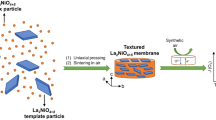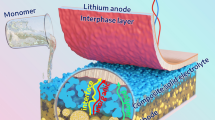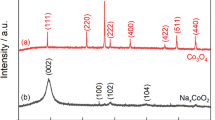Abstract
In order to improve the conductivity of ceria-based solid electrolytes, effect of co-doped Gd3+ and Dy3+ was evaluated. For this purpose, nano-crystalline Gd0.2 − x Dy x Ce0.8O1.9 powders with various composition ranges (x = 0.05, 0.1, 0.15, 0.2) were initially synthesized by high-energy milling method. The effect of micro-structural evolution and co-doping on electrical properties of the dense sintered samples fabricated by two-step sintering and conventional sintering of the synthesized powders were investigated. Electrical conductivity of the samples was discussed based on the results obtained by AC impedance spectroscopy at temperatures in the range of 300–700 °C. The co-doping and sintering regime were found to significantly influence the conductivity of the electrolytes. The electrical conductivity of the co-doped samples depends on Dy3+ content and the maximum conductivity obtained by 0.15 mol% Dy and 0.05 mol% Gd. The conductivity of Gd0.2 − x Dy x Ce0.8O1.9 (x = 0.15) was 0.03 S/cm at 700 °C. A thorough discussion was made, based on the present experimental data.









Similar content being viewed by others
References
Singhal SL, Kendall K (2003) High temperature solid oxide fuel cells: fundamental, design and applications. Elsevier, Oxford
Minh NQ (1993) Ceramic fuel cells. J Am Ceram Soc 76:563–588
Steele BCH (2000) Materials for IT-SOFC stacks: 35 years R&D: the inevitability of gradualness? Solid State Ionics 134:3–20
Inaba H, Tagawa H (1996) Ceria-based solid electrolytes. Solid State Ionics 83:1–16
Yashiro H, Eguchi K, Arai H (1989) Electrical properties and reducibilities of ceria-rare earth oxide and their application to solid oxide fuel cell. Solid State Ionics 36:71–75
Steele BCH (2000) Appraisal of Ce1 − y Gd y O2 − y/2 electrolytes for IT-SOFC operation at 500 °C. Solid State Ionics 129:95–110
Gerhardt-Anderson SR, Nowick AS (1981) Ionic conductivity of CeO2 with trivalent dopants of different ionic radii. Solid State Ionics 5:547–550
Tian C, Chan SW (2000) Ionic conductivities, sintering temperatures and microstructures of bulk ceramic CeO2 doped with Y2O3. Solid State Ionics 134:89–102
Mori T, Buchanan B, Ou DR, Ye F, Kobayashi T, Kim JD, Zou J, Drennan J (2008) Design of nanostructured ceria-based solid electrolytes for development of IT-SOFC. J Solid State Electrochem 12:841–849
Lapa CM, de Souza DPF, Figueiredo FML, Marques FMB (2010) Two-step sintering ceria-based electrolytes. Int J Hydrog Energy 35:2737–2741
Kilner JA, Brook RJ (1982) A study on oxygen ion conductivity in doped non-stoichiometric oxides. Solid State Ionics 6:237–252
Omar S, Wachsman ED, Nino JC (2006) A co-doping approach towards enhanced ionic conductivity in fluorite-based electrolytes. Solid State Ionics 177:3199–3208
Omar S, Wachsman ED, Jones JL, Nino JC (2009) Crystal structure-ionic conductivity relationships in doped ceria systems. J Am Ceram Soc 92:2674–2681
Anderson DA, Simak SI, Skorodumova NV, Abrikosov IA, Johansson B (2006) Optimization of ionic conductivity in doped ceria. Proc Natl Acad Sci U S A 103:3528–3521
Zheng Y, Shi Y, Gu H, Gao L, Chen H, Guo L (2009) La and Ca co-doped ceria-based electrolyte materials for IT-SOFCs. Mater Res Bull 44:1717–1721
Jaiswal N, Upadhyay S, Kumar D, Parkash O (2013) Ionic conductivity investigation in lanthanum (La) and strontium (Sr) co-doped ceria system. J Power Sources 222:230–236
Pikalova EY, Maragou VI, Demina AN, Demin AK, Tsiakaras PE (2008) The effect of co-dopant addition on the properties of Ln0.2Ce0.8O2 − δ (Ln = Gd, Sm, La) solid-state electrolyte. J Power Sources 181:199–206
Mori T, Yamamura H (1998) Preparation of alkali-elements or alkali-earth-element-doped CeO2-Sm2O3 system and its operation properties as the electrolyte in planar solid oxide fuel cells. J Mater Synth Process 6:175–179
Homgemi X, Hongge Y, Zhenhua C (2008) Preparation and properties of Y3+ and Ca2+ co-doped ceria electrolyte materials for ITSOFC. Solid State Sci 10:1179–1184
Wang FY, Chen S, Cheng S (2004) Gd3+ and Sm3+ co-doped ceria based electrolytes for intermediate temperature solid oxide fuel cells. Electrochem Commun 6:743–756
Lubke S, Wiemhofer HD (1999) Electronic conductivity of Gd-doped ceria with additional Pr-doping. Solid State Ionics 117:229–243
Wang F, Chen SY, Wang Q, Yu S, Cheng S (2004) Study on Gd and Mg co-doped ceria electrolyte for intermediate temperature solid oxide fuel cell. Catal Today 97:189–194
Dudek M, Bogusz W, Zych L, Trybalska B (2008) Electrical and mechanical properties of CeO2-based electrolytes in the CeO2-Sm2O3-M2-O3 (M = La, Y) system. Solid State Ionics 197:164–167
Yoshida H, Deguchi H, Miura K, Horiuchi M, Inagak T (2001) Investigation of the relationship between the ionic conductivity and the local structures of singly and doubly doped ceria compounds using EXAFS measurement. Solid State Ionics 140:191–199
Li B, Liu Y, Wei X, Pan W (2010) Electrical properties of ceria Co-doped with Sm3+ and Nd3+. J Power Sources 195:969–976
Zhao XL, Liu JJ, Xiao T, Wang JC, Zhang YX, Yao HC, Wang JS, Li ZJ (2012) Effect of Ca co-dopant on the electrical conductivity of Gd-doped ceria. J Electroceram 28:149–157
Cheng J, Jiang Q, He H, Yang J, Wang Y, Gao J (2011) Preparation and characterization of Y2O3-Sm2O3 co-doped ceria electrolyte for IT-SOFCs. Mater Chem Phys 125:704–708
Kim J, Lee D (2002) The effect of multiple doping on electrical conductivity of gadolinia-doped ceria electrolyte. Korean J Chem Eng 19:421–424
Zajac W, Molenda J (2008) Electrical conductivity of doubly doped ceria. Solid State Ionics 179:154–158
Acharya SA (2010) The effect of processing route on sinter ability and electrical properties of nano-sized dysprosium-doped ceria. J Power Sources 198:105–111
Haile SM, West DL, Campbell J (1998) The role of the microstructure and processing on the proton conducting properties of gadolinium-doped barium cerate. J Mater Res 13:1576–1595
Suk Kim D, Seok Cho P, Heun Lee J, Yeon Kim D, Lee SB (2006) Improvement of grain-boundary conduction in gadolinia-doped ceria via post-sintering heat treatment. Solid State Ionics 177:2125–2128
Khakpour Z, Youzbashi AA, Maghsoudipour A, Ahmadi K (2012) Electrical conductivity of Sm-doped CeO2 electrolyte produced by two-step sintering. Solid State Ionics 227:80–85
Khakpour Z, Youzbashi AA, Maghsoudipour A, Ahmadi K (2011) Synthesis of nano sized gadolinium doped ceria solid solution by high energy ball milling. Powder Technol 214:117–121
Williamson GK, Hall WH (1953) X-ray line broadening from filed aluminium and wolfram. Acta Metall 1:22–31
Khakpour Z, Youzbashi AA, Maghsoudipour A, Ahmadi K (2012) Electrical behavior of Gd-doped CeO2 electrolyte ceramics sintered from nano powders prepared by mechanical alloying process. J Mater Sci Mater Electron 23:786–794
Zhang TS, Ma J, Kong LB, Hing P, Leng YJ, Chan SH, Kilner JA (2003) Sinterability and ionic conductivity of co precipitated Ce0.8Gd0.2O2 − δ powders treated via a high-energy ball-milling process. J Power Sources 124:26
Aoki M, Chiang YM, Kosachi I, Lee LIR, Tuller H, Liu YP (1996) Solute segregation and grain-boundary impedance in high-purity stabilized zirconia. J Am Ceram Soc 79:1169–1180
Guo X, Waser R (2006) Electrical properties of the grain boundaries of oxygen ion conductors: acceptor-doped zirconia and ceria. Prog Mater Sci 51:151–210
Mori T, Kobayashi T, Wang Y, Drennan J, Nishimura T, Li JG, Kobayashi H (2005) Synthesis and characterization of nano-hetero-structured Dy doped CeO2 solid electrolytes using a combination of spark plasma sintering and conventional sintering. J Am Ceram Soc 88:1981–1984
Jiang SP, Love JG, Badwal SPS (1997) Electrochemical techniques in studies of solid ionic conductors. Key Eng Mater 125–126:81–132
Espositow V, Traversa E (2008) Design of electroceramics f or solid oxides fuel cell applications: playing with ceria. J Am Ceram Soc 91:1037–1051
Yamamura H, Katoh E, Ichikawa M, Kakinuma K, Mori T, Haneda H (2000) Multipledoping effect on the electrical conductivity in the (Ce1 − x − y La x M y )O2 − δ (M = Ca, Sr) system. Electrochemistry 455–459
Kim DJ (1989) Lattice parameters, ionic conductivities, and solubility limits in fluorite-structure MO2oxide [M = Hf4+, Zr4+, Ce4+, Th4+, U4+] solid solutions. J Am Ceram Soc 72:1415–1421
Lee JH, Mori T, Li JG, Ikegami T, Komatsu M, Haneda H (2000) Improvement of grain-boundary conductivity of 8 mol% yttria-stabilized zirconia by precursor scavenging of siliceous phase. J Electrochem Soc 147:2822–2829
Lee JH, Mori T, Li JG, Ikegami T, Drennan J, Kim DY (2002) Precursor scavenging of resistive grain-boundary phase in 8 mol% ytterbia-stabilized zirconia. J Electrochem Soc 149:J35–J40
Author information
Authors and Affiliations
Corresponding author
Rights and permissions
About this article
Cite this article
Khakpour, Z., Youzbashi, A.A. & Maghsoudipour, A. Influence of Gd3+ and Dy3+ co-doping and sintering regime on enhancement of electrical conductivity of ceria-based solid electrolyte. Ionics 20, 1407–1417 (2014). https://doi.org/10.1007/s11581-014-1090-7
Received:
Revised:
Accepted:
Published:
Issue Date:
DOI: https://doi.org/10.1007/s11581-014-1090-7




